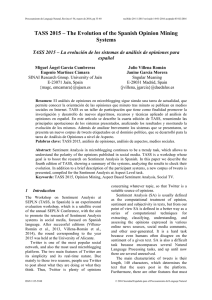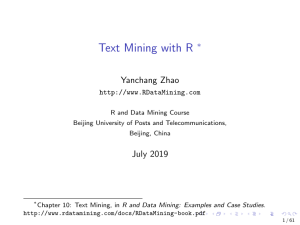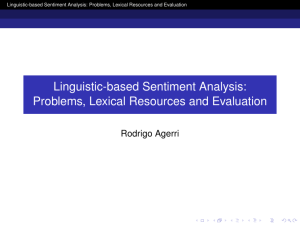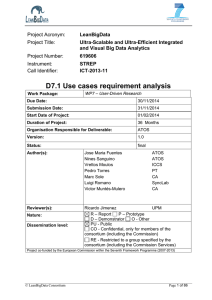TASS 2014 - The Challenge of Aspect-based Sentiment
Anuncio
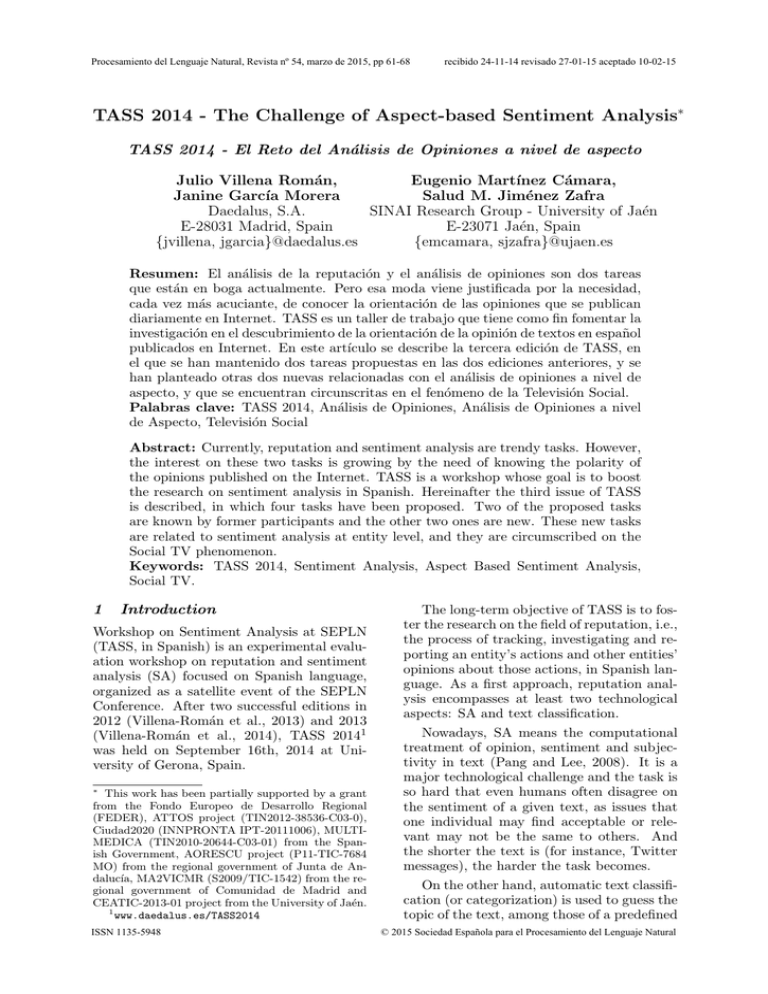
Procesamiento del Lenguaje Natural, Revista nº 54, marzo de 2015, pp 61-68
recibido 24-11-14 revisado 27-01-15 aceptado 10-02-15
TASS 2014 - The Challenge of Aspect-based Sentiment Analysis∗
TASS 2014 - El Reto del Análisis de Opiniones a nivel de aspecto
Julio Villena Román,
Eugenio Martı́nez Cámara,
Janine Garcı́a Morera
Salud M. Jiménez Zafra
Daedalus, S.A.
SINAI Research Group - University of Jaén
E-28031 Madrid, Spain
E-23071 Jaén, Spain
{jvillena, jgarcia}@daedalus.es
{emcamara, sjzafra}@ujaen.es
Resumen: El análisis de la reputación y el análisis de opiniones son dos tareas
que están en boga actualmente. Pero esa moda viene justificada por la necesidad,
cada vez más acuciante, de conocer la orientación de las opiniones que se publican
diariamente en Internet. TASS es un taller de trabajo que tiene como fin fomentar la
investigación en el descubrimiento de la orientación de la opinión de textos en español
publicados en Internet. En este artı́culo se describe la tercera edición de TASS, en
el que se han mantenido dos tareas propuestas en las dos ediciones anteriores, y se
han planteado otras dos nuevas relacionadas con el análisis de opiniones a nivel de
aspecto, y que se encuentran circunscritas en el fenómeno de la Televisión Social.
Palabras clave: TASS 2014, Análisis de Opiniones, Análisis de Opiniones a nivel
de Aspecto, Televisión Social
Abstract: Currently, reputation and sentiment analysis are trendy tasks. However,
the interest on these two tasks is growing by the need of knowing the polarity of
the opinions published on the Internet. TASS is a workshop whose goal is to boost
the research on sentiment analysis in Spanish. Hereinafter the third issue of TASS
is described, in which four tasks have been proposed. Two of the proposed tasks
are known by former participants and the other two ones are new. These new tasks
are related to sentiment analysis at entity level, and they are circumscribed on the
Social TV phenomenon.
Keywords: TASS 2014, Sentiment Analysis, Aspect Based Sentiment Analysis,
Social TV.
1
Introduction
Workshop on Sentiment Analysis at SEPLN
(TASS, in Spanish) is an experimental evaluation workshop on reputation and sentiment
analysis (SA) focused on Spanish language,
organized as a satellite event of the SEPLN
Conference. After two successful editions in
2012 (Villena-Román et al., 2013) and 2013
(Villena-Román et al., 2014), TASS 20141
was held on September 16th, 2014 at University of Gerona, Spain.
∗
This work has been partially supported by a grant
from the Fondo Europeo de Desarrollo Regional
(FEDER), ATTOS project (TIN2012-38536-C03-0),
Ciudad2020 (INNPRONTA IPT-20111006), MULTIMEDICA (TIN2010-20644-C03-01) from the Spanish Government, AORESCU project (P11-TIC-7684
MO) from the regional government of Junta de Andalucı́a, MA2VICMR (S2009/TIC-1542) from the regional government of Comunidad de Madrid and
CEATIC-2013-01 project from the University of Jaén.
1
www.daedalus.es/TASS2014
ISSN 1135-5948
The long-term objective of TASS is to foster the research on the field of reputation, i.e.,
the process of tracking, investigating and reporting an entity’s actions and other entities’
opinions about those actions, in Spanish language. As a first approach, reputation analysis encompasses at least two technological
aspects: SA and text classification.
Nowadays, SA means the computational
treatment of opinion, sentiment and subjectivity in text (Pang and Lee, 2008). It is a
major technological challenge and the task is
so hard that even humans often disagree on
the sentiment of a given text, as issues that
one individual may find acceptable or relevant may not be the same to others. And
the shorter the text is (for instance, Twitter
messages), the harder the task becomes.
On the other hand, automatic text classification (or categorization) is used to guess the
topic of the text, among those of a predefined
© 2015 Sociedad Española para el Procesamiento del Lenguaje Natural
Julio Villena Román, Eugenio Martínez Cámara, Janine García Morera, Salud M. Jiménez Zafra
vided to participants and used for the challenge tasks. The third section describes the
different tasks proposed in the 2014 edition.
Section 4 and 5 describes the participants and
the analysis of the results, and the last section draws some conclusions and future directions.
set of categories, so as to be able to assign the
reputation level into different axis or points
of view of analysis. Text classification techniques, albeit studied for a long time, still
need more research effort to be able to build
complex models with many categories with
less workload and increase the precision and
recall of the results. In addition, these models should deal with specific text features in
social media messages.
Up to now, TASS has proposed analyses at
document level (tweet level), but the SA research community are beginning to go a step
further, related to the fact that the society
needs a fine-grained study of people attitude
expressed on a tweet. Aspect-Based Sentiment Analysis (ABSA) is the task that is concerned with the extraction and classification
of opinions on a specific entity. An entity can
be decomposed into several parts or aspects,
so that can be seen as a hierarchical structure whose head is the entity. ABSA is not
only focused on opinions on entities, but also
each of the aspects that are part of an entity.
In a pragmatic way, an ABSA system does
not take into account the hierarchical relation between the entity and the aspects, and
both are considered in the same way. ABSA
encompasses two subtasks, aspect extraction
and aspect sentiment classification. The first
one empathizes on the identification of the
aspects presented on a text, and the second
one comprehends the classification of the attitude of the opinion holder about the aspect.
The previous paragraphs described
trendy, hard, and interesting tasks that are
basic for a posterior study of reputation.
Within this context, the aim of TASS is
to provide a forum for discussion the latest
research work in these fields. The setup is
based on a series of challenge tasks intended
to provide a benchmark forum for comparing
different approaches. Moreover, the aim
of TASS is to provide a common reference
dataset for the research community, so it is
generated and open-release the corpus fully
tagged. Polarity classification and topic
classification are two fixed tasks of TASS,
but due to the relevance of ABSA, the
2014 edition of TASS has included two new
tasks, aspect identification and aspect-based
polarity classification, which is focused on
the context of Social TV.
The rest of the paper is organized as follows. Section 2 describes the corpora pro-
2
Corpus
Experiments were based on two corpora. After the workshop, both were published only
for research purposes.
2.1
General corpus
The general corpus, which is the same used
in the previous two editions, contains over
68,000 tweets gathered between November
2011 and March 2012. The tweets are written in Spanish by about 150 well-known personalities and celebrities of the world of politics, economy, communication, mass media
and culture.
The general corpus was divided into two
sets: training (10%) and test (90%). Table
1 shows a summary of the training and test
corpora provided to participants.
Attributes
Tweets
Tweets (test)
Tweets (train)
Topics
Tweet languages
Users
User types
User languages
Date start (train)
Date end (train)
Date start (test)
Date end (test)
Value
68,017
60,798 (89%)
7,219 (11%)
10
1
154
3
1
2011-12-02 T00:47:55
2012-04-10 T23:40:36
2011-12-02 T00:03:32
2012-04-10 T23:47:55
Table 1: Features of the General Corpus
Each message in both the training and
test set was tagged with its global polarity, indicating whether the text expresses a
positive, negative or neutral sentiment, or
no sentiment at all. Five levels have been
defined: strong positive (P+), positive (P),
neutral (NEU), negative (N), strong negative (N+) and one additional no sentiment
tag (NONE).
Furthermore, the level of agreement of the
expressed sentiment within the text was also
included, to clarify whether a neutral sentiment comes from neutral keywords (AGREE62
TASS 2014 - The Challenge of Aspect-based Sentiment Analysis
MENT) or else the text contains positive and
negative sentiments at the same time (DISAGREEMENT).
On the other hand, a selection of a set
of topics was made based on the thematic
areas covered by the corpus, such as politics,
literature or entertainment. Each message in
both the training and test set was assigned
to one or several of these topics.
All tagging was carried out semi automatically: a baseline machine learning model was
first run (Villena-Román et al., 2011) and
then all tags were manually checked by two
human experts. For polarity at entity level,
due to the high volume of data to check, this
tagging was done just for the training set.
2.2
<t w e e t i d=” 4 5 6 5 4 4 8 9 8 7 9 1 9 0 7 3 2 8 ”>
<s e n t i m e n t a s p e c t=” Equipo−Real Madrid
” p o l a r i t y=”P”>#HalaMadrid</
s e n t i m e n t> ganamos s i n <s e n t i m e n t
a s p e c t=” Jugador−
C r i s t i a n o R o n a l d o ” p o l a r i t y=”NEU”
>C r i s t i a n o</ s e n t i m e n t> . . p e r d é i s
con <s e n t i m e n t a s p e c t=” Jugador−
L i o n e l M e s s i ” p o l a r i t y=”N”>M e s s i<
/ s e n t i m e n t> . Hala <s e n t i m e n t
a s p e c t=” Equipo−Real Madrid ”
p o l a r i t y=”P”>Madrid</ s e n t i m e n t> !
!!!!!
</ t w e e t>
<t w e e t i d=” 4 5 6 5 4 4 8 9 8 9 4 2 9 0 6 3 6 9 ”>
@nevermind2192 <s e n t i m e n t a s p e c t=”
Equipo−B a r c e l o n a ” p o l a r i t y=”P”>
Barça</ s e n t i m e n t> por s i e m p r e ! !
</ t w e e t>
<t w e e t i d=” 4 5 6 5 4 4 8 9 8 9 5 1 2 8 2 6 8 8 ”>
<s e n t i m e n t a s p e c t=” P a r t i d o ” p o l a r i t y=
”NEU”>#FinalCopa</ s e n t i m e n t> Hala
<s e n t i m e n t a s p e c t=” Equipo−
Real Madrid ” p o l a r i t y=”P”>Madrid<
/ s e n t i m e n t> , h a l a <s e n t i m e n t
a s p e c t=” Equipo−Real Madrid ”
p o l a r i t y=”P”>Madrid</ s e n t i m e n t> ,
campeón de l a <s e n t i m e n t a s p e c t=”
P a r t i d o ” p o l a r i t y=”P”>copa d e l
r e y</ s e n t i m e n t>
</ t w e e t>
Social-TV corpus
Social-TV corpus was collected during the
2014 Final of Copa del Rey championship
in Spain, between Real Madrid and F.C.
Barcelona. It was played on 16 April 2014
at Mestalla Stadium in Valencia.
Over 1 million of tweets were collected
from 15 minutes before to 15 minutes after
the match. After filtering useless information, tweets in other languages than Spanish,
a subset of 2773 was selected.
All tweets have been manually tagged
with the aspects of the expressed messages
and its sentiment polarity. Tweets may cover
more than one aspect.
The general defined aspects were: afición
(fans), árbitro (referee), autoridades (political authorities), entrenador (coach), equipo
(team), jugador (player), partido (game) and
retransmisión (broadcasting).
Some of the detailed aspects were:
Equipo-Barcelona,
Equipo-Real Madrid,
Jugador-Isco, Jugador-Dani Álves, and the
other players.
Sentiment polarity has been tagged from
the point of view of the person who writes the
tweet, using 3 levels: P (positive), NEU (neutral) and N (negative). No distinction was
made in cases when the author does not express any sentiment or when he/she expresses
a no-positive or no-negative sentiment.
The Social-TV corpus has been randomly
divided into two sets: training (1773 tweets)
and test (1000 tweets), with a similar distribution of both, aspects and sentiments.
The training set was released with the aim
of the participants could train and validate
their models. The test corpus was provided
Figure 1: Sample tweet (Social TV corpus)
without any tagging and was used to evaluate
the results provided by the different systems.
The list of the 31 aspects that have been defined can be read at the workshop webpage.
Figure 1 shows the information of three
sample tweets in the training set.
3
Description of tasks
The main goal of TASS is to boost the research on reputation and SA in Spanish.
With the aim of reaching it, the organization of TASS always proposed four tasks, two
of them that have the purpose of analysing
the evaluation of the investigation on SA and
Topic Classification, and another two ones
that are usually linked with needs of the society, which are usually voiced by a business
demand. The two fixed tasks of TASS are
Sentiment Analysis and Topic Classification
at document level, which will be described
hereinafter.
2014, in Spain, has been the year in which
the TV channels have greatly taken advantage of the social networks with the objective
of increasing the participation of the viewers in the TV shows. Last July, the CEO of
Twitter Spain, José López de Ayala, asserted
that the 66% of mobile phone users publish
63
Julio Villena Román, Eugenio Martínez Cámara, Janine García Morera, Salud M. Jiménez Zafra
tweets while they are watching TV. Also, he
pointed out that the TV ads, whose last image is a Twitter hashtag, they achieve to increase by 60% the number of tweets related to
that tag. Therefore, analyzing the sentiment
related to the phenomenon of Social TV was
a great candidate to be the target of a task.
The level of analysis required by a reputation
or SA system in the context of Social TV is
deeper than the proposed one in the traditional tasks of TASS, in plain English, Social
TV needs a fine-grained analysis. The level
of analysis needed in a Social TV context is
entity or aspect level. This is the reason why
this year two new tasks were proposed. The
new tasks required the development of SA
systems at aspect level.
tribution to the training corpus was extracted
and used for an alternate evaluation of the
performance of systems.
3.1
A given tweet ID can be repeated in different lines if it is assigned more than one
topic.
Micro averaged precision, Recall and F1measure calculated over the full test set will
be used to evaluate the systems. Systems
were ranked by F1. To allow the comparison with previous years, the same test corpus will be used for the evaluation. Again,
participants were not allowed to use any test
data to train their systems.
3.2
Task 2: Topic Classification
The challenge of this task is to automatically
identify the topic of each message in the test
set of the General corpus. Participants could
use the training set of the General corpus to
train and validate their models.
Participants were expected to submit up
to 3 experiments, each one in a plain text file
with the following format:
tweetid \t topic
Task 1: SA at Document Level
The first of the two fixed tasks of TASS is the
performing SA at document level. In the context of the workshop the task proposed the
development of polarity classification systems
at tweet level, in other words, build systems
to classify tweets in several predefined polarity classes. Six is the number of polarity labels (P+, P, NEU, N, N+, NONE) in which
the systems had to classify the tweets of the
general corpus. But the systems had to be
prepared to classify tweets in four labels (P,
NEU, N, NONE), because the performance of
the systems is evaluated in an environment of
six classes and four classes.
Accuracy was used for ranking the systems. Precision, Recall and F1-measure will
be used to evaluate each individual category.
Results were submitted in a plain text file
with the following format:
3.3
Task 3: Aspect Detection
The main objective of this task is the automatic identification of the different aspects
expressed by users, among a predefined list,
in their opinions expressed in Twitter about
a given topic. For example, in the following
tweet:
CR7 jugó bien, Messi no, el Madrid
se mereció la victoria
(CR7 played well, Messi didn’t, the
Madrid team deserved to win)
tweetid \t polarity
Three aspects can be identified CR7 as the
player Cristiano Ronaldo, Messi as the player
Lionel Messi and Madrid as the Real Madrid
team. This task is a multi-label classification
and tweets can have more than one aspect,
as shown in the example.
A new Social-TV corpus was delivered and
used for the training and evaluation of the
systems (see description above).
Participants are expected to submit up to
3 experiments, each in a plain text file with
the following format:
A given tweet id can be repeated in different lines if it is assigned more than one
where polarity could be: P+, P, NEU, N,
N+ and NONE for the 6-labels case; P, NEU,
N and NONE for the 4-labels case.
The same test corpus of previous years
was used for the evaluation, to allow comparison between systems. Obviously, participants were not allowed to use any test data
to train their systems. However, to deal with
the problem reported last years of the imbalanced distribution of labels between the
training and test set, a new selected test subset containing 1000 tweets with a similar dis64
TASS 2014 - The Challenge of Aspect-based Sentiment Analysis
Group
LyS
SINAI-ESMA
Elhuyar
SINAIword2vec
JRC
ELiRF-UPV
IPN
Total groups
tweetid \t aspect
aspect. We consider an aspect as the minimum set of words, not the detected terms or
fragment in neither the text nor its offsets.
As evaluation measures micro averaged
precision, recall and F1 were used, calculated
over the full test set. The final list of participants was ranked by F1.
3.4
2
X
3
X
4
X
X
X
3
X
X
2
2
Table 2: Participant groups
Task 4: Aspect-based SA
the description of their experiments and the
analysis of the results. These papers were reviewed by the program committee and were
included in the workshop proceedings. References are listed in Table 3.
Vilares et al. (2014) used a machine
learning approach, using several linguistic
resources and other information extracted
from the training corpus to feed to a supervised classifier. With respect to task 3,
they developed a naive approach, collecting
a set of representations to identify the predefined aspects requested by the organizers.
Jiménez Zafra et al. (2014) developed an
unsupervised classification system which is
based on the use of an opinion lexicon, and
on the application of a syntactic heuristic
for identifying the scope of Spanish negation words. San Vicente Roncal and Saralegi Urizar (2014) implemented a SVM algorithm that combines the information extracted from polarity lexicons with linguistic features. Montejo Ráez, Garcı́a Cumbreras, and Dı́az-Galiano (2014) used supervised learning with SVM over the summatory of word vectors in a model generated from the Spanish Wikipedia. PereaOrtega and Balahur (2014) focused on different feature replacements carried out for
both the development and test data sets provided. The replacements performed were
mainly based on repeated punctuation signs,
emoticons and affect words, by using an inhouse built dictionary for SA. Then, they
applied a machine learning approach to get
the polarity of the tweets. Hurtado and Pla
(2014) adapted the tweet tokenizer Tweetmotif (Connor, Krieger and Ahn, 2010) and they
used Freeling (Padro y Stanilovsky, 2012)
as lemmatizer, entity recognizer and morphosyntactic tagger. Hernández Petlachi and
Li (2014) proposal is based on semantic ap-
This task was similar to the first one, but
sentiment polarity (using 3 levels) should be
determined at aspect level of each tweet in
the Social-TV corpus (fine-grained polarity
detection). They worked with the aspects
detected in the previous task. Again, participants were provided with this Social-TV
corpus to train and evaluate their models.
Aspects were tagged in the corpus to make
participant focus on the polarity classification and not on aspect identification. The
complex of the task arises from the fact that
tweets can contain more than one sentence
with more than one aspect per sentence, so
more advance text processing techniques are
needed.
Participants were expected to submit up
3 experiments, each in a plain text file with
the following format:
tweetid \t aspect \t polarity
Allowed polarity values were P, NEU and
N.
Accuracy, micro averaged Precision, Recall and F1-measure was used to evaluate the
systems, considering a unique label combining aspect-polarity. Systems were ranked by
F1.
4
1
X
X
X
X
X
X
X
7
Participants
This year 35 groups registered (as compared
to 31 groups last year) and finally 7 groups
(14 last year) sent their submissions. The
list of active participant groups is shown in
Table 2, including the tasks in which they
have participated.
Along with the experiments, all participants were invited to submit a paper with
65
Julio Villena Román, Eugenio Martínez Cámara, Janine García Morera, Salud M. Jiménez Zafra
In order to perform a more in-depth evaluation, results are calculated considering the
classification only in 3 levels (POS, NEU,
NEG) and no sentiment (NONE) merging P
and P+ in only one category, as well as N and
N+ in another one. The same double evaluation using the whole test corpus and a new
selected corpus has been carried out, shown
in Table 5.
The distributions of successful tweets per
groups and per sentiment, for 3-level evaluation, are shown in Table 6 and Table 7.
proaches with linguistic rules for classifying
polarity texts in Spanish. Polarity classification in the words is done according to a
dictionary of semantic orientation where each
term is labeled with a use value and emotional value, along with linguistic rules to
solve various constructions that could affect
the polarity of text.
Group
LyS
SINAI-ESMA
Elhuyar
SINAIword2vec
JRC
ELiRF-UPV
IPN
Report
(Vilares et al., 2014)
(Jiménez Zafra et al., 2014)
(San Vicente Roncal and
Saralegi Urizar, 2014)
(Montejo
Ráez,
Garcı́a Cumbreras,
and
Dı́az-Galiano, 2014)
(Perea-Ortega and Balahur, 2014)
(Hurtado and Pla, 2014)
(Hernández Petlachi and Li, 2014)
# of groups
7
6
5
4
3
2
1
0
Table 3: Participant reports
5
Results
Table 6: Distribution of successful tweets per
groups, for 3-level evaluation
After the submission deadline, runs were collected and checked and results were evaluated
and made available to the participants using
an automated web page in the password protected area in the website. Results for each
task are described hereinafter.
5.1
Correct tweets
13112 (21.6%)
11215 (18.5%)
9898 (16.3%)
7512 (12.4%)
5536 (9.1%)
4716 (7.8%)
4595 (7.6%)
4214 (6.9%)
Label
P
N
NONE
NEU
Task 1: Sentiment Analysis at
Document Level
Task 1 includes the experiments using the full
test set and using the selected 1k test set.
Thirty-two runs for 5-level evaluation were
submitted by 7 different groups. Results for
the best-ranked experiment from each group
are listed in the tables below. All tables show
the precision (P), recall (R) and F1 value
achieved in each experiment. Table 4 considers 5 polarity levels, with the whole test
corpus. Accuracy values range from 0.64 to
0.37.
As previously described, an alternate evaluation of the performance of systems was
done using a new selected test subset containing 1000 tweets with a similar distribution
to the training corpus. Results are shown
also in next Table 4. Accuracy values range
from 0.48 to 0.33 (1k test corpus). Figures
are much lower as compared to the previous
evaluation, thus showing a high bias in the
semi-automatic tagging of the whole test corpus.
Correct tweets
22007 (36.2%)
15655 (25.7%)
18076 (29.7%)
846 (1.4%)
Table 7: Distribution of successful tweets per
sentiment, for 3-level evaluation
5.2
Task 2: Topic Classification
Table 8 shows the results for Task 2. Precision ranges from 67% to 27%. As in Task
1, different submissions from the same group
usually have similar values.
Run Id
ELiRF-UPV-run3
ELiRF-UPV-run2
ELiRF-UPV-run1
LyS-1
LyS-2
IPN-2
P
0.67
0.70
0.68
0.68
0.68
0.27
R
0.75
0.71
0.69
0.60
0.59
0.33
Table 8: Results for Task 2
66
F1
0.70
0.70
0.69
0.64
0.63
0.30
TASS 2014 - The Challenge of Aspect-based Sentiment Analysis
Run Id
ELiRF-UPV-run3
ELiRF-UPV-run1
ELiRF-UPV-run2
Elhuyar-Run1
Elhuyar-Run3
Elhuyar-Run2
LyS-1
LyS-2
SINAIword2vec-1
SINAI-ESMA-1
SINAI-ESMA-without negation
Acc.
0.64
0.63
0.63
0.61
0.61
0.61
0.58
0.56
0.51
0.51
0.51
Acc.
0.48
0.48
0.47
0.47
0.47
0.47
0.46
0.46
0.45
0.42
0.41
0.48
1k-Run Id
ELiRF-UPV-run1-1k
ELiRF-UPV-run3-1k
Elhuyar-Run2-1k
Elhuyar-Run3-1k
ELiRF-UPV-run2-1k
Elhuyar-Run1-1k
SINAIword2vec-1-1k
LyS-2-1k
LyS-1-1k
JRC-run3-baseline-stop-1k
JRC-run1-ER-1k
JRC-run2-RPSN-ER-AWM-4-all2-skipbigrams-1k
SINAI-ESMA-without negation-1k
JRC-run1-ER
JRC-run2-RPSN-ER-AWM-4-all2-skipbigrams
JRC-run3-baseline-stop
IPN-Linguistic 2
IPN-1
0.48
0.48
0.37
0.37
SINAI-ESMA-1-1k
IPN-Linguistic 2-1k
IPN-1-1k
0.37
0.35
0.33
0.40
0.37
Table 4: Task 1, classification on 5 levels
Run Id
ELiRF-UPV-run2
ELiRF-UPV-run1
ELiRF-UPV-run3
Elhuyar-Run1
Elhuyar-Run2
Elhuyar-Run3
LyS-1
LyS-2
SINAIword2vec-2
JRC-run2-RPSN-ER-AWM-4-all2-skipbigrams
SINAI-ESMA-1
JRC-run1-ER
Acc.
0.71
0.71
0.70
0.70
0.70
0.70
0.67
0.67
0.61
1k-Run Id
ELiRF-UPV-run3-1k
ELiRF-UPV-run1-1k
LyS-2-1k
Elhuyar-Run3-1k
SINAIword2vec-2-1k
Elhuyar-Run2-1k
LyS-1-1k
Elhuyar-Run1-1k
SINAIword2vec-1-1k
Acc.
0.66
0.65
0.64
0.64
0.63
0.63
0.63
0.62
0.61
0.61
ELiRF-UPV-run2-1k
0.60
0.61
0.61
0.56
0.56
SINAI-ESMA-without negation
0.60
JRC-run3-baseline-stop
SINAIword2vec-1
IPN-Linguistic 2
0.60
0.59
0.55
JRC-run1-ER-1k
JRC-run3-baseline-stop-1k
JRC-run2-RPSN-ER-AWM-4-all2-skipbigrams-1k
SINAI-ESMA-1-1k
SINAI-ESMA-without negation-1k
IPN-Linguistic 2-1k
0.55
0.52
0.52
0.52
Table 5: Task 1, classification on 3 levels
5.3
Task 3: Aspect Detection
5.4
Last, results for Task 4 are shown in Table 10.
Once we have identified a representation of
an aspect, the next step consists of detecting
its scope of influence, i.e. the fragment of the
text, which is talking about the aspect that
was referred to and its SA.
The results are similar and robust and do
not drop too low compared to those obtained
on the while test corpus.
The aim of task 3 is detecting the aspects
from a predefined list, related with the football domain, and using the Social-TV corpus.
Results for Task 3 are shown in Table 9.
Run Id
ELiRF-UPV-run1
LyS-1
P
0.91
0.81
R
0.91
0.90
Task 4: Aspect-Based SA
F1
0.91
0.85
6
Conclusions and Future Work
Each edition of TASS has a positive conclusion because every year the Spanish SA
research community improves their systems
Table 9: Results for Task 3
67
Julio Villena Román, Eugenio Martínez Cámara, Janine García Morera, Salud M. Jiménez Zafra
Run Id
ELiRF-UPV-run2
ELiRF-UPV-run1
ELiRF-UPV-run3
LyS-2
LyS-1
LyS-3
P
0.58
0.57
0.56
0.52
0.51
0.46
R
0.60
0.59
0.58
0.58
0.57
0.51
sinai word2vec en tass 2014. In Proceedings of the TASS workshop at SEPLN.
Gerona, Spain, September.
F1
0.59
0.58
0.57
0.55
0.54
0.48
Pang, Bo and Lillian Lee. 2008. Opinion
mining and sentiment analysis. Found.
Trends Inf. Retr., 2(1-2):1–135, January.
Perea-Ortega, José M. and Alexandra Balahur. 2014. Experiments on feature
replacements for polarity classification
of spanish tweets.
In Proceedings of
the TASS workshop at SEPLN. Gerona,
Spain, September.
Table 10: Results for Task 4
and results. It is very important to note that
the general results obtained are comparable
to those of the international community. Two
aspects are noteworthy, the first one is related to the fact that each edition is increasing the number of unsupervised or at least
semi-supervised systems. This is important
because they do not need prior knowledge to
perform the classification, which is scarce in
the dynamic context of social networks. The
other issue is related to the fact that the systems submitted try to use the last methods
in the state of the art, like classifiers based
on deep learning.
The main purpose for future editions is
to continue increasing the number of participants and the visibility of the workshop in
international forums.
San Vicente Roncal, Iñaki and Xabier Saralegi Urizar. 2014. Looking for features
for supervised tweet polarity classification. In Proceedings of the TASS workshop
at SEPLN. Gerona, Spain, September.
Vilares, David, Yerai Doval, Miguel A.
Alonaso, and Carlos Gómez-Rodrı́guez.
2014.
Lys at tass 2014: A prototype for extracting and analysing aspects
from spanish tweets. In Proceedings of
the TASS workshop at SEPLN. Gerona,
Spain, September.
Villena-Román, Julio, Sonia Collada-Pérez,
Sara Lana-Serrano, and José Carlos González Cristóbal. 2011. Hybrid
approach combining machine learning
and a rule-based expert system for text
categorization.
In Proceedings of the
24th International Florida Artificial
Intelligence Research Society Conference
(FLAIRS). AAAI Press.
References
Hernández Petlachi, Roberto and Xiaoou Li.
2014. Análisis de sentimiento sobre textos en español basado en aproximaciones
semánticas con reglas lingüı́sticas. In Proceedings of the TASS workshop at SEPLN.
Gerona, Spain, September.
Villena-Román, Julio, Janine Garcı́aMorena,
Sara Lana-Serrano,
and
José Carlos González-Cristóbal. 2014.
Tass 2013 - a second step in reputation
analysis in Spanish. Procesamiento del
Lenguaje Natural, 52(0):37–44.
Hurtado, Lluı́s and Ferrán Pla. 2014. Elirfupv en tass 2014: Análisis de sentimientos, detección de tópicos y análisis de sentimientos de aspectos en twitter. In Proceedings of the TASS workshop at SEPLN.
Gerona, Spain, September.
Villena-Román, Julio, Sara Lana-Serrano,
Eugenio Martı́nez-Cámara, and José Carlos González-Cristóbal. 2013. Tass workshop on sentiment analysis at SEPLN. Procesamiento del Lenguaje Natural, 50:37–44.
Jiménez Zafra,
Salud M.,
Eugenio
Martı́nez Cámara, M. Teresa Martı́n Valdivia, and L. Alfonso Ureña López. 2014.
Sinai-esma: An unsupervised approach
for sentiment analysis in twitter.
In
Proceedings of the TASS workshop at
SEPLN. Gerona, Spain, September.
Montejo Ráez,
Arturo,
M. Ángel
Garcı́a Cumbreras, and M. Carlos
Dı́az-Galiano. 2014. Participación de
68
